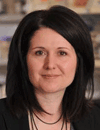08:00 | Registration |
|
Formulation Strategies | Session Sponsors |
| |
09:00 |  | Keynote Presentation CANCELLED - Understanding How Solution Conditions Affect Stability by Investigating Site-Specific Changes Within Proteins
Jennifer Laurence, Associate Professor, University of Kansas, United States of America
A novel peptide sequence that binds a metal ion and generates a unique peptide-metal complex having a negative charge and controlled release properties is being developed. We engineered this tag into a set of polypeptides and examined its ability to modulate solubility and stability. |
|
10:00 | Prediction of in vivo Performance during Formulation Development
Nikoletta Fotaki, Lecturer, University of Bath, United Kingdom
This talk will describe methods used for the prediction of the in vivo performance during formulation development. The factors that need to be taken into account for a predictive in vitro testing will be described and practices for successful predictions will be addressed. |
10:30 | Coffee and Networking in Exhibiton Hall |
11:15 |  | Keynote Presentation The Future of Formulation and Drug Delivery in Global Healthcare Provision
Sven Stegemann, Director, Capsugel, Belgium
The talk will address the impact of the changing healthcare with regard to emerging markets, patient populations, diagnostics, systems biology and personalized medicines. Looking from a holistic perspective, the future trends and directions are discussed. |
|
12:15 | Lunch and Networking in Exhibition Hall |
13:30 | Poster Viewing Session |
14:15 | Shear-stress Sensitive Lenticular Vesicles for Targeted Drug Delivery
Andreas Zumbuehl, Swiss National Science Foundation Professor, University of Fribourg, Switzerland
Drug carriers that can release drugs locally with such rheological changes can be very useful, e.g., for treating atherosclerosis. Here, we show that vesicles made from a artificial 1,3-diaminophospholipid are stable under static conditions but release their contents at elevated shear stress. |
14:45 | A Biodegradable Nanomaterial for in vivo Cell Tracking and Efficient Pro-survival/Angiogenic miRNA Delivery
Lino Ferreira, Principal Investigator, Biocant Center, Portugal
The ability to monitor transplanted cells in vivo by non-invasive imaging methods such as magnetic resonance imaging (MRI) and to simultaneously manipulate them by intracellular delivery of miRNAs is important in the context of regenerative medicine. The formulation reported here uses FDA-approved components, which should facilitate its biomedical translation. |
15:15 | Coffee and Networking in Exhibiton Hall |
16:00 | Tumour Regression after Intravenous Administration of Novel Targeted Anti-cancer Therapeutic Systems
Christine Dufes, Senior Lecturer, University of Strathclyde, United Kingdom
The possibility of using genes as medicines to treat cancer is limited by the lack of efficacious delivery systems able to selectively deliver genes to tumours. We demonstrated that the intravenous administration of a tumour-targeted dendriplex led to tumour disappearance of 90% of the tested tumours over one month. |
16:30 | Characterization Strategies for Metastable Drug Formulations
Eric Munson, Professor, University of Kentucky, United States of America
Advanced characterization techniques will be presented that focus on predicting whether metastable drug formulations, such as metastable polymorphs or amorphous formulations, will transform into their more stable form, resulting in reduced bioavailability and drug product failure. |
|
Optimisation of Bioavailability Through Formulation |
| |
17:00 | Forcing the HIV Virus to Box Below its Weight Using Antiretroviral Nanomedicine
Steve Rannard, Group Leader & Vice Chair, University of Liverpool, United Kingdom
Nanomedicine formulations of antiretrovirals have been utilised to generate options for oral dosing of HIV patients. A detailed screening approach of material properties (size, charge, stabilisers), pharmacology, toxicology and in vivo studies have led to optimisation of materials with enhanced activity and bioavailability. |
17:30 | End of Day One |


